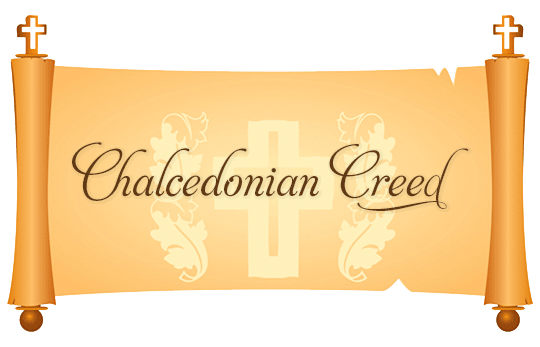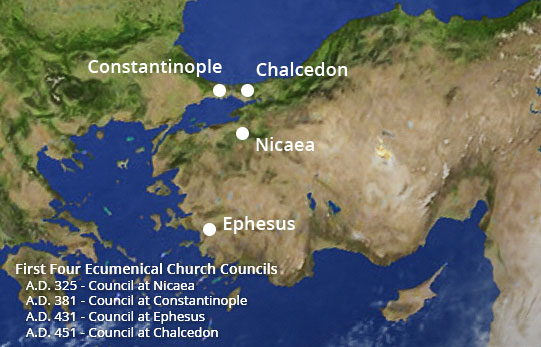Bible Question:
What is the Chalcedonian Creed of A.D. 451?
Bible Answer:
There are four major creeds for the Christian faith. They are the Apostles’ Creed, the Nicene Creed of A.D. 325, the Chalcedonian Creed of A.D. 451 and the Athanasian Creed. The Chalcedonian Creed was adopted during the fourth and fifth sessions of the fourth ecumenical council at the city of Chalcedeon in Asia Minor, now modern day Turkey on 22 October and 25 October A.D. 451.[1]

Reason For The Council
The Council of Nicene in A.D. 325 refuted the heresy of Arius known as Arianism. Arius had taught that Christ was a created being and was not of the same essence or substance (heteroousios) of the Father. Arius taught that Jesus was not God, that He was inferior to the Father. The Council affirmed in the Nicene Creed that Jesus was eternally God. The opening statement of the creed stated,
And in one Lord Jesus Christ, the only begotten Son of God, begotten of the Father before all worlds, light from light, Very God of very God, begotten not made, being of one substance with the Father . . .
The fact that 318 eastern bishops had supported the creed did not stop those who taught the heresy. In fact, the Nicene Creed motivated them to more fervently support their false teaching. In reaction, faithful Christians such as Athanasius continued to defend the truth that Christ was and is our eternal God.
The Council at Chalcedeon in A.D. 451 was convened to address the growing Arian heresy, as well as the Nestorian and Eutychian heresies.[2] The Nestorian heresy states that Christ was two separate persons in one body. He was the person of God and the person of a man. He had two separate natures and two wills which shared one body. The Eutychian heresy taught that Christ was divine and human; but the human nature was essentially absorbed into the divine nature, thus denying that Christ was truly divine and human.[3] In response the Council at Chalcedon taught that Christ was completely divine and completely human. This truth is commonly expressed as Christ is one hundred percent God and one hundred percent human. The Chalcedonian creed states that Jesus is completely God and man . . .
. . . our Lord Jesus Christ, the same perfect in Godhead and also perfect in manhood; truly God and truly man, of a reasonable (rational) soul and body; consubstantial with the Father according to the Godhead, and consubstantial with us according to the Manhood; in all things like unto us, without sin . . .
The creed continues by stating that the two natures exist together . . .
. . . in two natures, inconfusedly, unchangeably, indivisibly, inseparably; the distinction of natures being by no means taken away by the union, but rather of the property of each nature being preserved, and concurring in one Person and one Subsistence . . .
Here is the full Chalcedonian Creed of A.D. 451.
Chalcedonian Creed (October 22, 451)
We, then, following the holy Fathers, all with one consent, teach men to confess one and the same Son, our Lord Jesus Christ, the same perfect in Godhead and also perfect in manhood; truly God and truly man, of a reasonable [rationale] soul and body; consubstantial [coessential] with the Father according to the Godhead, and consubstantial with us according to the Manhood; in all things like unto us, without sin; begotten before all ages of the Father according to the Godhead, and in these latter days, for us and for our salvation, born of the Virgin Mary, the Mother of God, according to the Manhood; one and the same Christ, Son, Lord, Only-begotten, to be acknowledged in two natures, inconfusedly, unchangeably, indivisibly, inseparably; the distinction of natures being by no means taken away by the union, but rather of the property of each nature being preserved, and concurring in one Person and one Subsistence, not parted or divided into two persons, but one and the same Son, and only begotten, God, the Word, the Lord Jesus Christ; as the prophets from the beginning (have declared) concerning him, and the Lord Jesus Christ himself has taught us, and the Creed of the holy Fathers has handed down to us.[4]

Conclusion:
The creed confirms the teaching of Scripture that Jesus Christ was completely God and completely human. Romans 1:3-4 states that Jesus Christ was both man and God. The phrase “Son of God” means God.
Concerning His Son, who was born of a descendant of David according to the flesh, who was declared the Son of God with power by the resurrection from the dead, according to the Spirit of holiness, Jesus Christ our Lord. Romans 1:3-4 (NASB)
Philippians 2:5-7 is the passage that states Jesus was completely God and completely man. He was and is the God-man.
Have this attitude in yourselves which was also in Christ Jesus, who, although He existed in the form of God, did not regard equality with God a thing to be grasped, but emptied Himself, taking the form of a bond-servant, and being made in the likeness of men. Philippians 2:5-7 (NASB)
References:
1. Philip Schaff. The Creeds of Christendom. Baker Books. 1996. vol. 1. p. 29.
2. Ibid., p. 30.
3. Ibid., p. 31.
4. Philip Schaff. The Creeds of Christendom. Baker Books. 1996. vol. 2. pp. 62-63.
Suggested Links:
What is the Apostles’ Creed of the third or fourth century A.D.?What is the Nicene Creed of A.D. 325?
What is the Episcopalian Creed?
What are the Eighteen Articles of Faith of 1833?
What is the meaning that Jesus is the Son of God?
What is the Athanasian Creed of A.D. 570? – Symbolum Quicunque